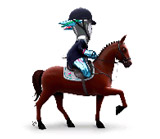Competition dates
Thursday 30 August – Tuesday 4 September
Competition venue
Greenwich Park
Number of competitors
78 – men and women compete together.
Classification
Grades Ia, Ib, II, III and IV. Grade Ia is for athletes whose impairment has the greatest impact on their ability to ride, and Grade IV has the least impact.
Number of medal events
11: Individual Championship and Freestyle Tests across all five classification grades, as well as a Team Test.
Field of play
The Dressage competition takes place in a 60m x 20m arena( Grade IV) or 40m x 20m (Grades I-III).
History of Dressage at the Paralympics
Equestrian events first appeared on the Paralympic programme at the 1984 Games held in Stoke Mandeville and New York, and have featured at every Games since Atlanta 1996.
The basics
Athletes compete in three Dressage tests where they have to perform a series of pre-determined movements which differ by grade and ability: a Team Test (with three to four riders per team), an Individual Championship Test, and a Freestyle Test, for which athletes choose their own movements and music. Through the tests, horse and rider must be in harmony, and the overall picture must be of lightness and rhythm.
The system of grades ensure that the tests can be judged on the skill of the rider, regardless of their disability. Riders may use permitted assistive devices such as dressage crops and connecting rein bars; visually impaired riders are permitted to use callers to help them navigate around the arena.
For a complete set of rules, please refer to the website of the International Equestrian Federation (FEI), governing body for the sport.
Competition format
Riders first complete the Team Test within their grades, followed by the Individual Championship Test, looking to get the best possible scores from the judges. After this the scores of both tests are added together to make the Team score, with the best three scores across all the grades counting. Individual medals are also awarded for each grade on the merit of the Individual Championship Test.
After this riders undertake the Freestyle Test, competing for individual medals in each grade in this event.
Read more about Paralympic Equestrian classification
Officials
A jury of five judges watches each athlete/horse combination and awards marks out of ten for the different movements that make up the routine, as well as the routine as a whole. These scores are then combined and turned into a percentage to give a final score.
Keys to success
Dressage is about the strong relationship a rider has with their horse. It is a sport of grace and pinpoint precision. With the balance, position and movement of both horse and rider under constant scrutiny, the winning athlete and horse must work in perfect harmony.
The judges award marks against exacting standards, where even a slight imperfection will lose marks. They are on the lookout for irregular or jerky movement, steps that are too large or too small, and riders and horses working well together.
Jargon buster
Canter – a steady controlled gait for which three of the horse’s legs are off the ground at once.
Full-pass – when a horse moves sideways, bent in the direction of movement.
Half-pass – when a horse moves forwards and sideways at the same time, bent in the direction of movement.
Self-carriage – when a horse moves in balance without support from the reins.
Get involved
If you want to find out about Equestrian sport in your country, including clubs, facilities and coaching schemes, check the website of your National Governing Body for Equestrian. To find out how you can get involved in Equestrian sport in the UK, go to thegamesandbeyond.com
For more information on the Equestrian competition at London 2012 and the rules of the sport, go to the website of the International Equestrian Federation (FEI), governing body for the sport.










